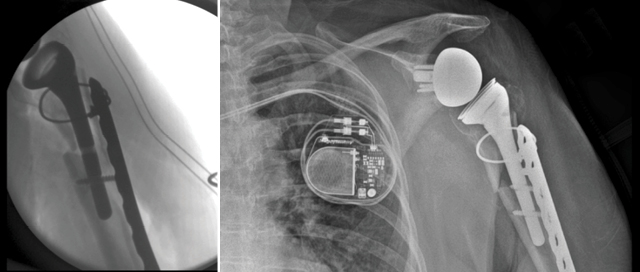

Johns Hopkins orthopaedic surgeons are combining a novel prosthesis for shoulder replacement with a metal plate to make a sturdier repair of fractures in the proximal humerus, midshaft and farther down the humerus.
The prosthesis has a stem with multiple holes along the distal aspect of the shaft, making it possible to connect to the bone with long screws. These holes also enable surgeons to interlock the prosthesis with a plate, offering stronger, more rigid repairs of fractures located below the stem.
While traditionally the shoulder prosthesis is connected to a metal plate using cable and a small screw, “securing the stem and plate with interlocking screws is easier and can be faster than passing cables,” says orthopaedic surgeon Uma Srikumaran. “And it’s definitely stronger with the screws going all the way across the plate, the prosthesis and the bone.”
The absence of cement is another advantage. “If something is off rotationally or out of alignment and you want to make an adjustment, you just remove the screws, make the adjustment and replace the screws,” he says. “It’s a lot faster than having to dig out the cement and start over.”
Share Fast Facts
.@HopkinsOrtho surgeons found interlocking screws provide stronger humerus fracture repairs & #shoulder replacements. #surgery Click to Tweet
When there are fractures farther down the humerus, the prosthesis may be a better alternative to press-fit stems, says Srikumaran, mainly because press fitting makes it more difficult for the surgeon to set specific characteristics, such as height and tension for the reverse shoulder prosthesis.
“This repair allows us to get patients moving sooner because it’s more rigid, which is also an advantage because the more rigidity you have,” he says, “the easier it is to tension the tightness between the ball and the socket without compromising the fracture fixation.”
One recent case highlights the capability of the prosthesis in combination with a plate, Srikumaran says. An 85-year-old woman who fell at home initially had traditional surgery to repair her shoulder. Two weeks later, she felt a pop while at physical therapy, and an X-ray revealed a failed humeral nail implant. Srikumaran employed the new prosthesis with a plate, and she was able to return to therapy soon after.
“The unique stem allows for flexibility to handle such complex cases,” says Srikumaran. “In fact, we’re working with the company that makes it to develop even longer stems that would have more holes for additional capabilities.”

